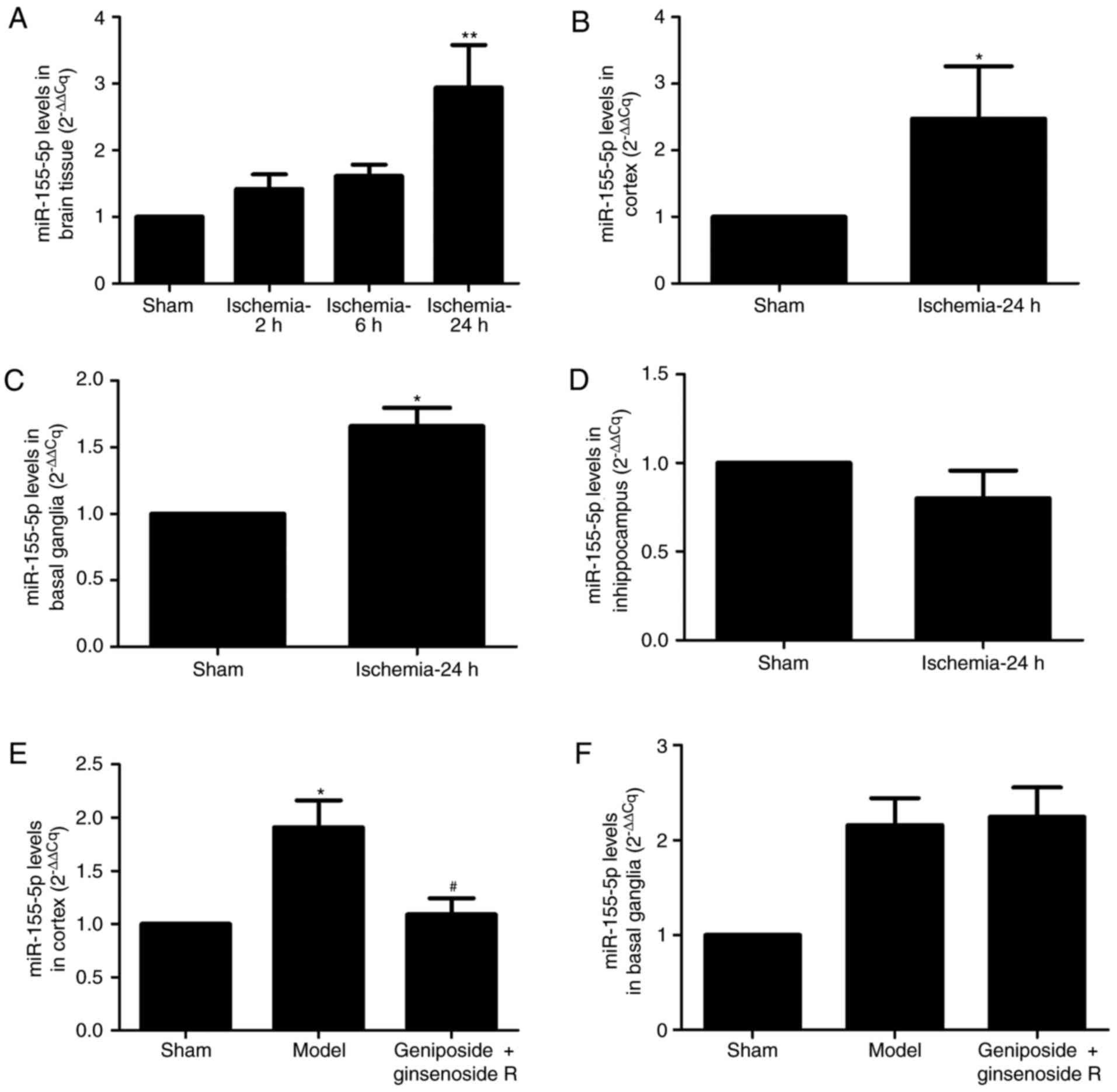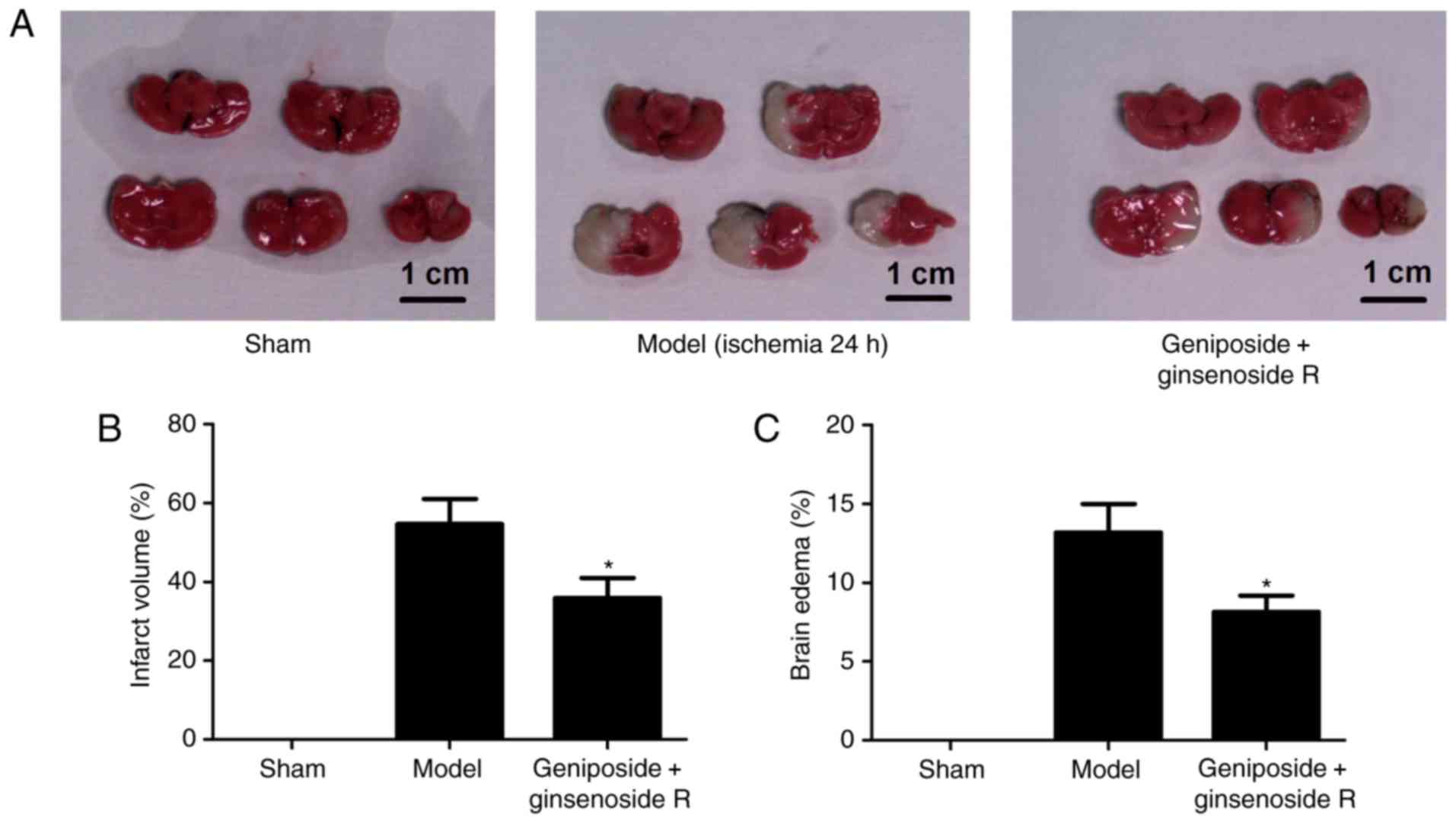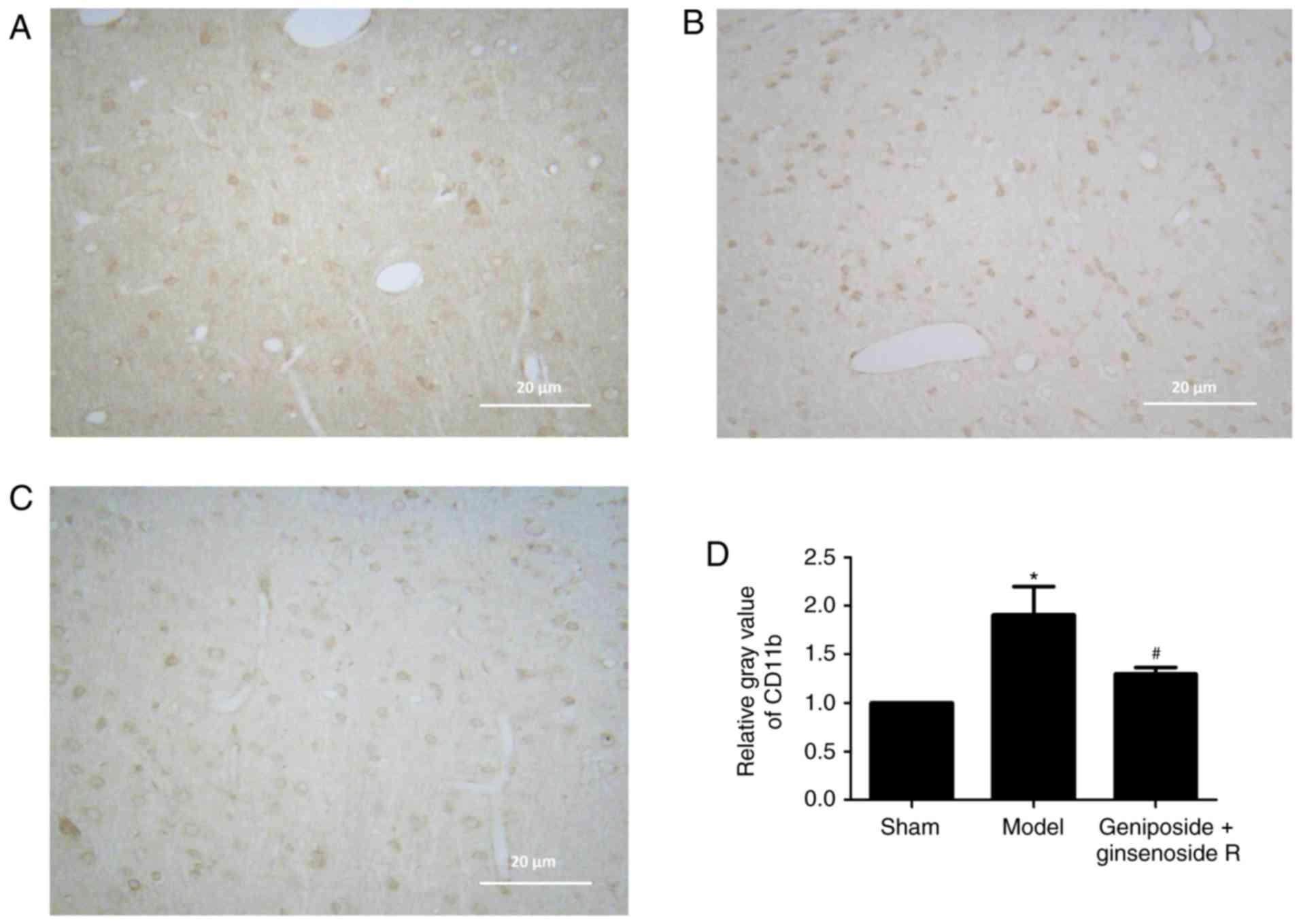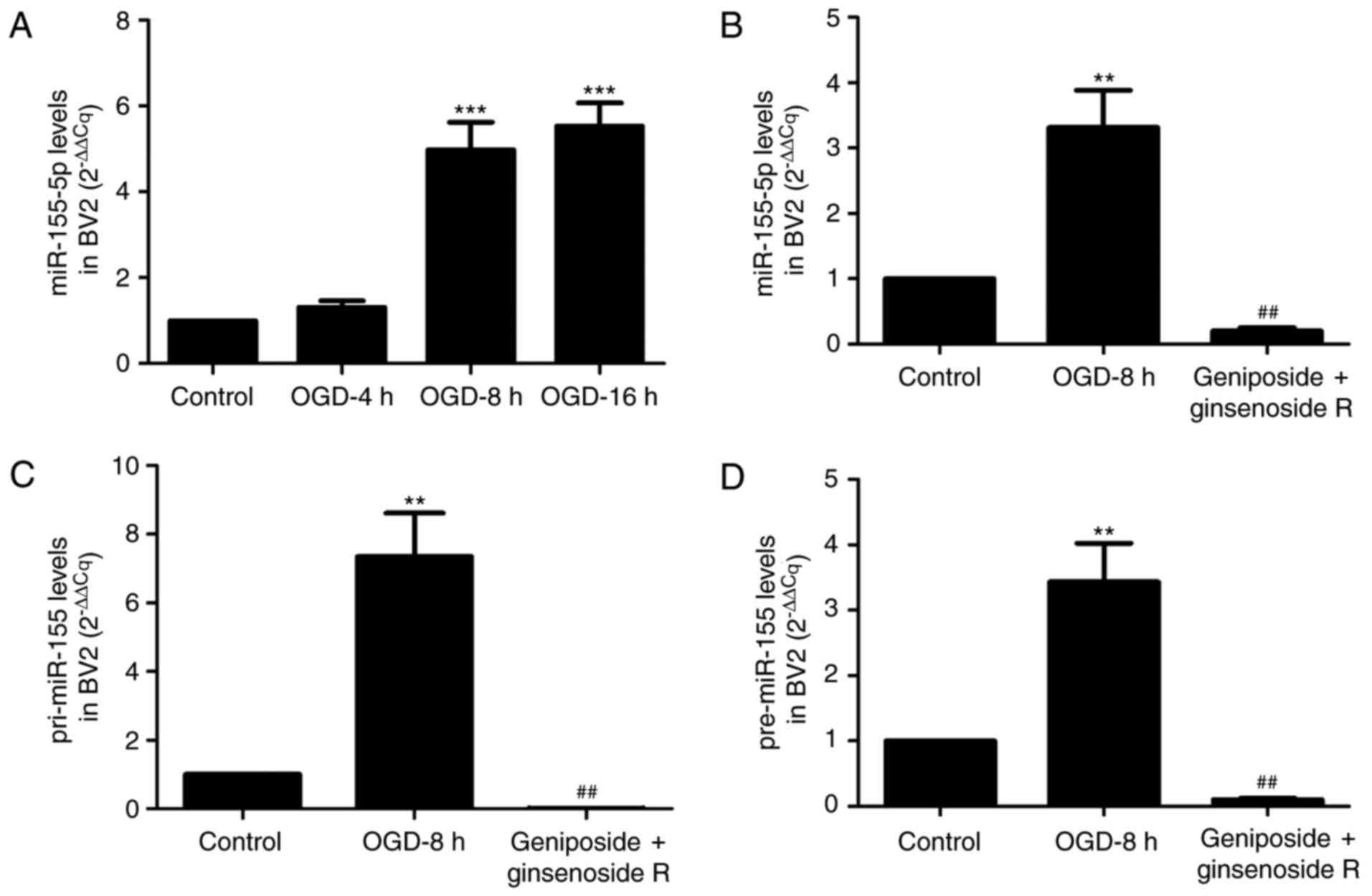|
1
|
Xu F, Li J, Ni W, Shen YW and Zhang XP:
Peroxisome proliferator-activated receptor-gamma agonist
15d-prostaglandin J2 mediates neuronal autophagy after cerebral
ischemia-reperfusion injury. PLoS One. 8:e550802013. View Article : Google Scholar : PubMed/NCBI
|
|
2
|
Cheng CY and Lee YC: Anti-Inflammatory
effects of traditional chinese medicines against ischemic injury in
in vivo models of cerebral ischemia. Evidence Based Complement
Alternat Med. 2016:57394342016. View Article : Google Scholar
|
|
3
|
Liu X, Tao Y, Wang F, Yao T, Fu C, Zheng
H, Yan Y, Liang X, Jiang X and Zhang Y: Kudiezi injection mitigates
myocardial injury induced by acute cerebral ischemia in rats. BMC
Complement Alternat Med. 17:82017. View Article : Google Scholar
|
|
4
|
Ambros V: The functions of animal
microRNAs. Nature. 431:350–355. 2004. View Article : Google Scholar : PubMed/NCBI
|
|
5
|
Bartel DP: MicroRNAs: Target recognition
and regulatory functions. Cell. 136:215–233. 2009. View Article : Google Scholar : PubMed/NCBI
|
|
6
|
Lau P and Hudson LD: MicroRNAs in neural
cell differentiation. Brain Res. 1338:14–19. 2010. View Article : Google Scholar : PubMed/NCBI
|
|
7
|
Rybak A, Fuchs H, Smirnova L, Brandt C,
Pohl EE, Nitsch R and Wulczyn FG: A feedback loop comprising lin-28
and let-7 controls pre-let-7 maturation during neural stem-cell
commitment. Nat Cell Biol. 10:987–993. 2008. View Article : Google Scholar : PubMed/NCBI
|
|
8
|
White RE and Giffard RG: MicroRNA-320
induces neurite outgrowth by targeting ARPP-19. Neuroreport.
23:590–595. 2012. View Article : Google Scholar : PubMed/NCBI
|
|
9
|
Lim KY, Chua JH, Tan JR, Swaminathan P,
Sepramaniam S, Armugam A, Wong PT and Jeyaseelan K: MicroRNAs in
Cerebral Ischemia. Transl Stroke Res. 1:287–303. 2010. View Article : Google Scholar : PubMed/NCBI
|
|
10
|
Liu DZ, Tian Y, Ander BP, Xu H, Stamova
BS, Zhan X, Turner RJ, Jickling G and Sharp FR: Brain and blood
microRNA expression profiling of ischemic stroke, intracerebral
hemorrhage, and kainate seizures. J Cereb Blood Flow Metab.
30:92–101. 2010. View Article : Google Scholar : PubMed/NCBI
|
|
11
|
Liu Y, Zhang J, Han R, Liu H, Sun D and
Liu X: Downregulation of serum brain specific microRNA is
associated with inflammation and infarct volume in acute ischemic
stroke. J Clin Neurosci. 22:291–295. 2015. View Article : Google Scholar : PubMed/NCBI
|
|
12
|
Faraoni I, Antonetti FR, Cardone J and
Bonmassar E: miR-155 gene: A typical multifunctional microRNA.
Biochim Biophys Acta. 1792:497–505. 2009. View Article : Google Scholar : PubMed/NCBI
|
|
13
|
O'Connell RM, Kahn D, Gibson WS, Round JL,
Scholz RL, Chaudhuri AA, Kahn ME, Rao DS and Baltimore D:
MicroRNA-155 promotes autoimmune inflammation by enhancing
inflammatory T cell development. Immunity. 33:607–619. 2010.
View Article : Google Scholar : PubMed/NCBI
|
|
14
|
Dheen ST, Kaur C and Ling EA: Microglial
activation and its implications in the brain diseases. Curr Med
Chem. 14:1189–1197. 2007. View Article : Google Scholar : PubMed/NCBI
|
|
15
|
Butovsky O, Jedrychowski MP, Cialic R,
Krasemann S, Murugaiyan G, Fanek Z, Greco DJ, Wu PM, Doykan CE,
Kiner O, et al: Targeting miR-155 restores abnormal microglia and
attenuates disease in SOD1 mice. Ann Neurol. 77:75–99. 2015.
View Article : Google Scholar : PubMed/NCBI
|
|
16
|
Cardoso AL, Guedes JR, Pereira de Almeida
L and Pedroso de Lima MC: miR-155 modulates microglia-mediated
immune response by down-regulating SOCS-1 and promoting cytokine
and nitric oxide production. Immunology. 135:73–88. 2012.
View Article : Google Scholar : PubMed/NCBI
|
|
17
|
Pareek S, Roy S, Kumari B, Jain P,
Banerjee A and Vrati S: MiR-155 induction in microglial cells
suppresses Japanese encephalitis virus replication and negatively
modulates innate immune responses. J Neuroinflammation. 11:972014.
View Article : Google Scholar : PubMed/NCBI
|
|
18
|
Chen QC, Zhang WY, Kim H, Lee IS, Ding Y,
Youn UJ, Lee SM, Na M, Min BS and Bae K: Effects of Gardeniae
Fructus extract and geniposide on promoting ligament cell
proliferation and collagen synthesis. Phytother Res. 24 Suppl
1:S1–S5. 2010. View
Article : Google Scholar : PubMed/NCBI
|
|
19
|
Wang J, Li PT, Du H, Hou JC, Li WH, Pan YS
and Chen HC: Tong Luo Jiu Nao injection, a traditional Chinese
medicinal preparation, inhibits MIP-1β expression in brain
microvascular endothelial cells injured by oxygen-glucose
deprivation. J Ethnopharmacol. 141:151–157. 2012. View Article : Google Scholar : PubMed/NCBI
|
|
20
|
Wang SW, Lai CY and Wang CJ: Inhibitory
effect of geniposide on aflatoxin B1-induced DNA repair synthesis
in primary cultured rat hepatocytes. Cancer Lett. 65:133–137. 1992.
View Article : Google Scholar : PubMed/NCBI
|
|
21
|
Lee P, Lee J, Choi SY, Lee SE, Lee S and
Son D: Geniposide from Gardenia jasminoides attenuates neuronal
cell death in oxygen and glucose deprivation-exposed rat
hippocampal slice culture. Biol Pharm Bull. 29:174–176. 2006.
View Article : Google Scholar : PubMed/NCBI
|
|
22
|
Wang J, Hou J, Zhang P, Li D, Zhang C and
Liu J: Geniposide reduces inflammatory responses of oxygen-glucose
deprived rat microglial cells via inhibition of the TLR4 signaling
pathway. Neurochem Res. 37:2235–2248. 2012. View Article : Google Scholar : PubMed/NCBI
|
|
23
|
Zhang Y, Lin SX, Hua Q, Yang KY, Yao N, Yi
LS, Wang AM, Chen WJ and Chen JY: Research on the mechanism of the
active ingredients of Sanchi and Gardenia removing the early
amyloid in the AD transgenic mouse brain. Chin Pharmacol Bull.
28:179–84. 2012.(In Chinese).
|
|
24
|
Zhai YS, Du SY, Lu Y, Wang Y, Xu B and Gao
Y: Impact of notoginseng total saponin on intestinal absorption
kinetics of jasminoidin. China J Trad Chin Med Pharm. 25:459–462.
2010.
|
|
25
|
Lanou W, Heqin Z, Wenjun H and Wenfeng C:
Analysis of behavioral index of ginsenoside_RG 1 intervention on
brain ischemia. Chin J Lab Ani Sci. 14:283–285. 2004.
|
|
26
|
Xia L, Cuifen B, Jia W, Jia L and Shujian
Q: The protective role and mechanism of Ginsenoside Rg1 on the
ischemic-reperfusion injuried neurons in hippocampus CA1 of rat.
Progress Anat Sci. 16:177–180. 2010.
|
|
27
|
Hollands C: The animals (scientific
procedures) act 1986. Lancet. 2:32–33. 1986. View Article : Google Scholar : PubMed/NCBI
|
|
28
|
Longa EZ, Weinstein PR, Carlson S and
Cummins R: Reversible middle cerebral artery occlusion without
craniectomy in rats. Stroke. 20:84–91. 1989. View Article : Google Scholar : PubMed/NCBI
|
|
29
|
Liu JH, Feng D, Zhang YF, Shang Y, Wu Y,
Li XF and Pei L: Chloral hydrate preconditioning protects against
ischemic stroke via upregulating annexin A1. CNS Neuroscience Ther.
21:718–726. 2015. View Article : Google Scholar
|
|
30
|
Chang CF, Lin SZ, Chiang YH, Morales M,
Chou J, Lein P, Chen HL, Hoffer BJ and Wang Y: Intravenous
administration of bone morphogenetic protein-7 after ischemia
improves motor function in stroke rats. Stroke. 3:558–564. 2003.
View Article : Google Scholar
|
|
31
|
Livak KJ and Schmittgen TD: Analysis of
relative gene expression data using real-time quantitative PCR and
the 2(-Delta Delta C(T)) method. Methods. 25:402–408. 2001.
View Article : Google Scholar : PubMed/NCBI
|
|
32
|
Brouns R and De Deyn PP: The complexity of
neurobiological processes in acute ischemic stroke. Clin Neurol
Neurosurg. 111:483–495. 2009. View Article : Google Scholar : PubMed/NCBI
|
|
33
|
Liguz-Lecznar M and Kossut M: Influence of
inflammation on poststroke plasticity. Neural Plast.
2013:2585822013. View Article : Google Scholar : PubMed/NCBI
|
|
34
|
Taganov KD, Boldin MP and Baltimore D:
MicroRNAs and immunity: Tiny players in a big field. Immunity.
26:133–137. 2007. View Article : Google Scholar : PubMed/NCBI
|
|
35
|
O'Connell RM, Rao DS, Chaudhuri AA and
Baltimore D: Physiological and pathological roles for microRNAs in
the immune system. Nat Rev Immunol. 10:111–122. 2010. View Article : Google Scholar : PubMed/NCBI
|
|
36
|
Xiao C and Rajewsky K: MicroRNA control in
the immune system: Basic principles. Cell. 136:26–36. 2009.
View Article : Google Scholar : PubMed/NCBI
|
|
37
|
Zhu J, Yue H, Qiao C and Li Y: Association
between single-nucleotide polymorphism (SNP) in miR-146a,
miR-196a2, and miR-499 and risk of ischemic stroke: A
meta-analysis. Med Sci Monit. 21:3658–3663. 2015. View Article : Google Scholar : PubMed/NCBI
|
|
38
|
Wang J, Yang K, Zhou L, Minhaowu, Wu Y,
Zhu M, Lai X, Chen T, Feng L, Li M, et al: MicroRNA-155 promotes
autophagy to eliminate intracellular mycobacteria by targeting
Rheb. PLoS Pathog. 9:e10036972013. View Article : Google Scholar : PubMed/NCBI
|
|
39
|
Wen Y, Zhang X, Dong L, Zhao J, Zhang C
and Zhu C: Acetylbritannilactone modulates MicroRNA-155-mediated
inflammatory response in ischemic cerebral tissues. Mol Med.
21:197–209. 2015. View Article : Google Scholar : PubMed/NCBI
|
|
40
|
Oliveira BRSM, Vieira FV, De S Vieira D,
da Silva SEL, Gameiro R, Flores EF and Cardoso TC: Expression of
miR-155 associated with Toll-like receptors 3, 7, and 9
transcription in the olfactory bulbs of cattle naturally infected
with BHV5. J Neurovirol. 23:772–778. 2017. View Article : Google Scholar : PubMed/NCBI
|
|
41
|
Zheng X, Yang D, Liu X, Wang N, Li B, Cao
H, Lu Y, Wei G, Zhou H and Zheng J: Identification of a new
anti-LPS agent, geniposide, from Gardenia jasminoides Ellis, and
its ability of direct binding and neutralization of
lipopolysaccharide in vitro and in vivo. Int Immunopharmacol.
10:1209–1219. 2010. View Article : Google Scholar : PubMed/NCBI
|
|
42
|
Xie CL, Li JH, Wang WW, Zheng GQ and Wang
LX: Neuroprotective effect of ginsenoside-Rg1 on cerebral
ischemia/reperfusion injury in rats by downregulating
protease-activated receptor-1 expression. Life Sci. 121:145–151.
2015. View Article : Google Scholar : PubMed/NCBI
|
|
43
|
Silverman J and Muir WW III: A review of
laboratory animal anesthesia with chloral hydrate and chloralose.
Lab Anim Sci. 43:210–216. 1993.PubMed/NCBI
|
|
44
|
Smith JA, Das A, Ray SK and Banik NL: Role
of pro-inflammatory cytokines released from microglia in
neurodegenerative diseases. Brain Res Bull. 87:10–20. 2012.
View Article : Google Scholar : PubMed/NCBI
|
|
45
|
Vilhardt F: Microglia: Phagocyte and glia
cell. Int J Biochem Cell Biol. 37:17–21. 2005. View Article : Google Scholar : PubMed/NCBI
|













